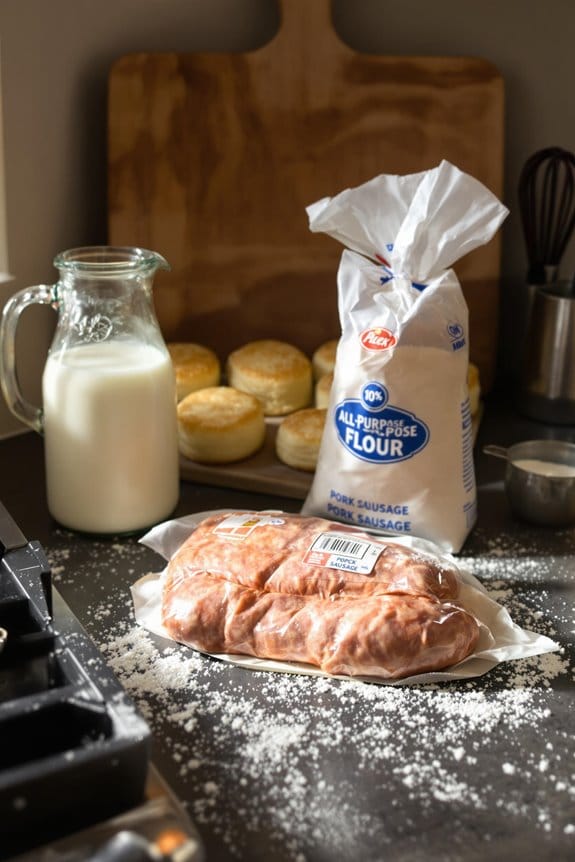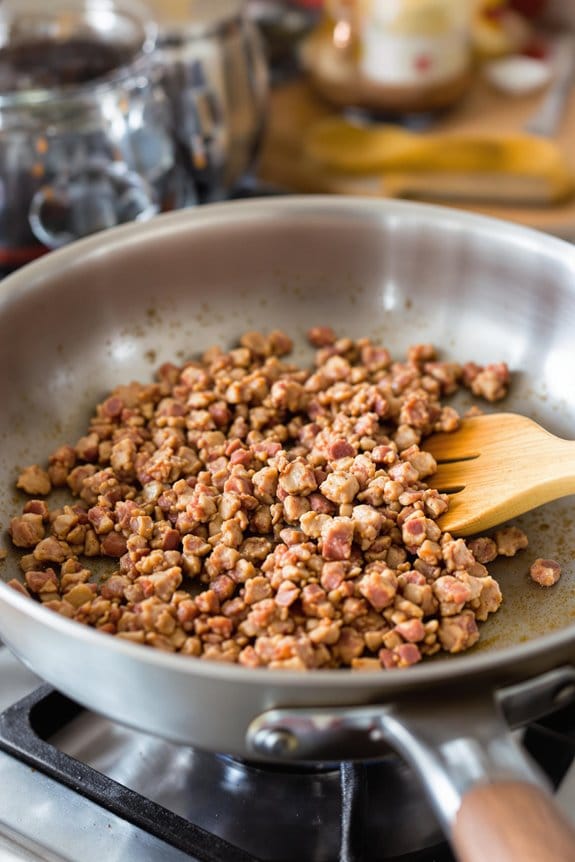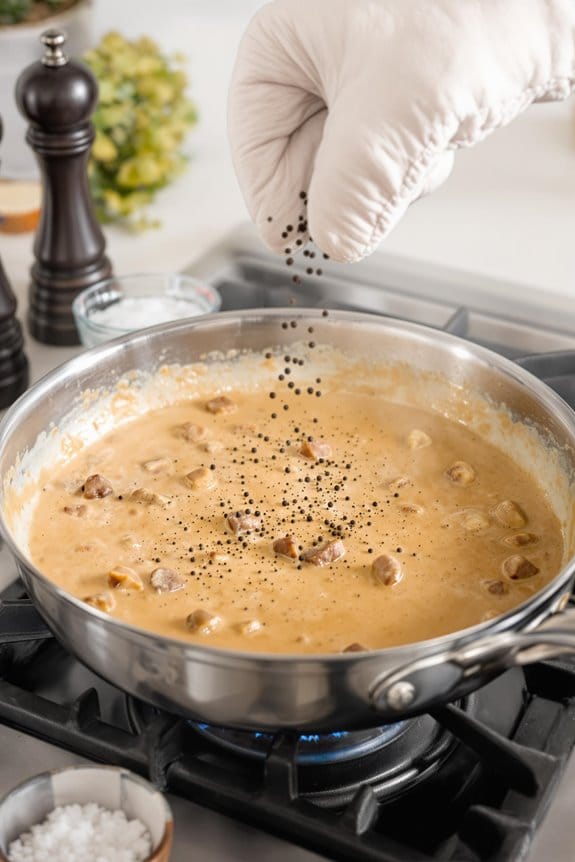As you explore the world of Southern cuisine, the rich flavors of country-style sausage gravy and biscuits certainly catch your attention. This dish not only encapsulates the essence of comfort food but also carries a storied history that mirrors the simplicity and resourcefulness of early American life. Imagine starting your day with a plate of warm, buttery biscuits smothered in thick, creamy gravy—a reflection of its lasting presence in family kitchens and diners across the South. What might seem just a hearty breakfast option holds layers of cultural significance waiting to be explored. What could this tell us about the evolution of American culinary traditions?
History
While country-style sausage gravy and biscuits might seem quintessentially Southern today, their origins trace back to the hearty breakfasts of early American settlers.
These pioneers, enduring long, labor-intensive days, relied on filling, energy-packed meals. Sausage gravy over biscuits, using readily available ingredients like pork and flour, offered a practical solution to morning hunger.
As you trace the dish’s history further, you’ll discover its evolution, particularly during the American Civil War. Economically, the recipe made sense; it required few ingredients that could all be sourced locally.
It wasn’t just the convenience but also the comfort provided by a hot, savory meal that embedded it deep into Southern culture.
Post-war, this breakfast staple found its way into Southern kitchens more frequently. It became synonymous with rural life, where families often raised pigs and grew their own food.
The simple recipe, which could be easily expanded to feed large groups, was perfect for communal settings and large family gatherings, helping to cement its place in Southern tradition.
You’ll find that sausage gravy and biscuits aren’t just a meal but a reflection of practicality, resilience, and community, rooted deeply in the American spirit.
Recipe
Country-style sausage gravy and biscuits are a hearty, comforting dish that epitomizes the simplicity and savoriness of Southern cooking. This traditional breakfast, beloved in many parts of the United States, features soft, flaky biscuits smothered in a rich, creamy sausage gravy. The contrast between the light biscuits and the hearty gravy makes it a favorite for both special weekend breakfasts and weekday meals.
To make this recipe, start by preparing homemade biscuits, or for a quicker version, you can use pre-made, refrigerated biscuit dough from the grocery store. The gravy, made from the drippings of cooked sausage, flour, and milk, is simple yet flavorful. This dish is best served warm, right after the gravy is cooked and poured over freshly-baked biscuits.
Ingredients:
- 1 pound pork sausage (breakfast sausage with sage or spicy, depending on preference)
- 1/4 cup all-purpose flour
- 2 cups milk
- Salt to taste
- Black pepper to taste
- 8 biscuits (homemade or pre-made)
Cooking Instructions:
In a large skillet, cook the sausage over medium heat until brown and crumbly. Once cooked, reduce the heat to low and sprinkle the flour over the sausage. Stir the flour into the sausage until fully absorbed, then gradually add the milk while stirring continuously.
Increase the heat to medium-high and continue to stir until the gravy thickens and bubbles. Season with salt and pepper. Serve the gravy hot over freshly baked biscuits.
Extra Tips:
When making the gravy, ascertain the flour is fully integrated into the fat from the sausage to avoid lumps. If your gravy is too thick, you can thin it by adding more milk a little at a time until you reach the desired consistency.
For an extra touch of flavor, consider adding a pinch of cayenne pepper or a few dashes of Worcestershire sauce. Remember, the key to fluffy biscuits is to handle the dough as little as possible, so it retains its light texture. Enjoy your meal hot for the best experience.
Step 1. Gather Ingredients for Gravy

Preparing the perfect sausage gravy starts with gathering the right ingredients. To begin with, you’ll need a good quality bulk pork sausage, typically seasoned with sage and black pepper—this will be your gravy’s flavor foundation.
Next, flour plays an essential role as it thickens the gravy; standard all-purpose flour works best, providing a smooth, creamy texture. Don’t forget about the milk; whole milk is ideal for lending that rich, decadent consistency.
For seasoning, keeping it simple is key—a bit of salt and some freshly ground black pepper can do wonders. Some prefer a pinch of cayenne pepper or paprika to add just a hint of heat.
Also consider having fresh stock or water on hand to adjust if your gravy gets too thick.
Finally, while biscuits are the classic companion for your gravy, consider how you’ll serve it. Some fresh chopped parsley or chives on top can add a touch of freshness and enhance the visual appeal.
Make sure you have everything measured and at your fingertips before you start cooking, as things can move quickly once the sausage hits the skillet.
Step 2. Prep and Cook Sausage

Now that you’ve gathered all your ingredients, it’s time to focus on preparing the sausage, the heart of your gravy. Start by selecting the right skillet. A well-seasoned cast-iron skillet does wonders as it distributes heat evenly, guaranteeing your sausage cooks perfectly.
Here’s how to prepare and cook your sausage:
- Crumble the Sausage: Remove your sausage from its casing if it isn’t already loose. Place it in the skillet over medium heat. Using a wooden spoon or spatula, break the sausage into small, bite-sized pieces. This not only helps it cook uniformly but also maximizes the surface area for a richer flavor in your gravy.
- Stir Frequently: As the sausage begins to brown, stir frequently. This prevents sticking and guarantees that every piece is perfectly cooked, golden, and crispy.
- Pay close attention to color changes and sizzling sounds, which indicate that your sausage is cooking properly.
- Drain Excess Fat: Once your sausage is thoroughly cooked — no pink should remain — carefully drain off the excess fat. Retaining a little fat in the pan may be necessary to help create a luscious gravy base.
Now, with your cooked sausage ready, you’ll appreciate how its robust flavor lays the foundational stone for your creamy, savory sausage gravy.
Step 3. Add Flour to Cooked Sausage

Sprinkle flour evenly over the cooked sausage still in the skillet, stirring it in thoroughly to coat the meat. This step is vital for setting the foundation of your gravy. The flour acts as a thickening agent, guaranteeing that your gravy will have that rich, creamy texture we all love.
You’ll want to cook the flour-sausage mixture for a few minutes, usually about 1-2 minutes. Keep stirring during this time to prevent any burning. This also helps cook off the raw flour taste, which is important for achieving the perfect gravy flavor.
By cooking the flour with the sausage, you’re fundamentally creating what chefs call a roux. This mixture, when later combined with liquid, thickens and enriches it, forming the base of your gravy.
Confirm that the flour is well-incorporated with the fat released from the sausage. This integration is key for a smooth texture in your final product. If the flour isn’t fully mixed with the fat, your gravy might end up lumpy.
Step 4. Stir in Milk Gradually

After the roux forms by cooking the sausage with flour, gradually add milk to the skillet while continuously stirring to prevent any lumps from forming. This step is essential; if you pour in all the milk at once, you’ll risk the smooth texture of your gravy by creating lumps that are tough to dissolve later.
Here’s how to ace the milk addition:
- Start with a Splash: Begin by adding just a small splash of milk. This initial amount is vital as it allows you to integrate the liquid slowly, ensuring the flour absorbs it evenly. Stir well after this first addition.
- Increase Gradually: Once the first splash is fully incorporated and the mixture is smooth, continue adding milk in smaller increments. Each time you add more milk, stir until the mixture returns to a consistent texture before adding more.
- Maintain Low Heat: Keep the heat low to medium-low during this process. It aids in controlling the thickening rate and prevents the bottom from scorching, which can impart a burnt flavor to your gravy.
New Recipe
- Pepperoni and Hot Honey PizzaTry the tantalizing twist of pepperoni pizza with hot honey, where sweet meets heat—how will it transform your taste buds?
Step 5. Season and Simmer Gravy

Once your gravy base is smooth and fully integrated with the milk, it’s time to enhance the flavors. Start by seasoning with salt and freshly ground black pepper. Don’t be shy with the spices; a generous pinch of each brings out the rich savoriness of the sausage.
It’s also the perfect time to add a teaspoon of ground sage for an earthy note, and a pinch of cayenne pepper or crushed red pepper flakes if you’re keen on a little kick.
After seasoning, let the gravy simmer on low heat. This slow cooking process is essential as it allows the flavors to meld beautifully. Stir occasionally to prevent the bottom from sticking and burning, keeping the texture smooth and even.
You’ll notice it gradually thickening as it simmers; this is when its flavors deepen and develop. Aim for about 10 to 15 minutes of simmering, or until the gravy reaches a rich and creamy consistency.
Keep an eye on the thickness—if it seems too thick, you can always thin it out with a splash more milk. This final adjustment guarantees your gravy’s perfect texture and taste, custom-fit for your homemade biscuits. Enjoy the homestyle goodness!
Cooking Tips
While making country-style sausage gravy and biscuits, it’s vital to master a few cooking techniques to enhance the flavor and texture.
Here’s a breakdown of key strategies to guarantee your dish turns out perfectly every time:
1. Properly Brown the Sausage:
Don’t rush browning your sausage; it’s essential for a rich, deep flavor. Cook the sausage over medium heat, breaking it into small chunks as it cooks.
You’re aiming for a crisp, uniformly browned texture, which will add savory depth to your gravy.
2. Stir Constantly When Adding Flour:
Once your sausage is browned, sprinkle the flour over it while stirring constantly. This process, known as making a roux, is vital to avoid lumps in your gravy.
It also helps in thickening the gravy to the right consistency, making sure it clings lovingly to your biscuits.
3. Season Throughout Cooking:
Season your gravy in layers. Start with a pinch of salt and pepper with the sausage and then adjust again after adding the milk.
This method allows the flavors to meld beautifully, creating a harmonious blend that elevates the entire dish.
Implement these tips, and you’ll elevate your cooking game, making a dish that’s not just homemade, but reminiscent of country warmth and hospitality.
Final Thoughts
With these kitchen strategies freshly in your toolkit, you’re well-equipped to make a batch of country-style sausage gravy and biscuits that will impress. This hearty dish isn’t just food; it’s a slice of comfort served warm to bring smiles around your table.
You’ve learned that the key is in the details—from selecting quality sausage to mastering the roux, which thickens your gravy to just the right consistency.
Remember, practice makes perfect. Your first attempt mightn’t be flawless, but each batch will bring you closer to perfection. Use the freshest ingredients for the best flavors and don’t rush the cooking process. The gravy should simmer gently to develop its rich flavors and velvety texture, so patience is essential.
Serve your sausage gravy over freshly baked biscuits for a touch that echoes generations of tradition. It’s more than just a meal; it’s an experience that can transport you to a southern kitchen, regardless of where you are.
Finally, don’t forget to personalize the recipe. Whether it’s a dash of cayenne for heat or a sprinkle of sage for earthiness, make the dish your own. This personal touch turns a classic recipe into a signature one, showcasing your culinary flair.








